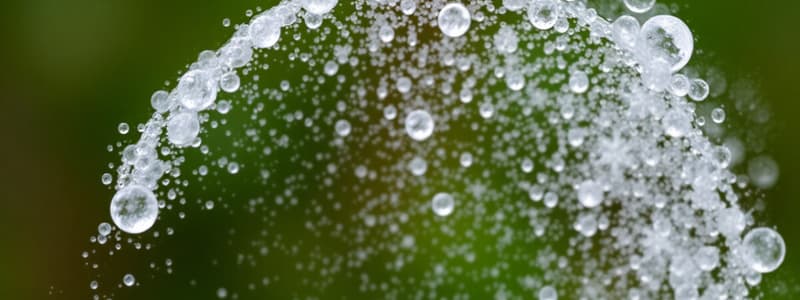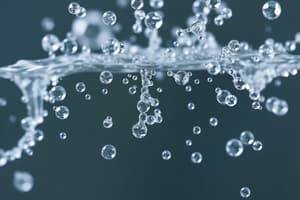Podcast
Questions and Answers
What causes a liquid to cool during the process of evaporation?
What causes a liquid to cool during the process of evaporation?
- Fast-moving particles escape, leaving slower ones behind. (correct)
- There is more space between particles during evaporation.
- All particles in the liquid move at the same speed.
- The temperature of the remaining liquid increases as particles escape.
Which of the following best describes evaporation?
Which of the following best describes evaporation?
- A reaction between gas and liquid that produces energy.
- A process where liquid converts into solid.
- The movement of solid particles into a gaseous state.
- The escape of particles from a liquid to the air when they gain enough energy. (correct)
How does sweating help cool the body?
How does sweating help cool the body?
- By increasing the rate of temperature in surrounding air.
- By adding energy to the skin surface.
- By removing energy from the body as the sweat evaporates. (correct)
- By promoting the absorption of heat through liquid formation.
In the model of evaporative cooling, how is the average speed of particles affected?
In the model of evaporative cooling, how is the average speed of particles affected?
What is a direct result of a liquid absorbing energy from the air during evaporation?
What is a direct result of a liquid absorbing energy from the air during evaporation?
Flashcards
What is evaporation?
What is evaporation?
The process where liquid changes state from liquid to gas. Fast-moving particles at the surface gain enough energy to break free and escape into the air.
How does evaporation cause cooling?
How does evaporation cause cooling?
When a liquid evaporates, it takes heat energy with it, leaving behind a cooler liquid. This is because the fastest particles escape, lowering the average energy and temperature of the remaining liquid.
Explain the evaporation model using children's heights.
Explain the evaporation model using children's heights.
Imagine 10 children with different heights. Calculating the average height helps understand how the speed of particles influences temperature during evaporation. The fastest particles escape (tallest kids leaving), leaving the average speed (height) lower.
How does sweating cool the body?
How does sweating cool the body?
Signup and view all the flashcards
Give examples of using evaporation for cooling.
Give examples of using evaporation for cooling.
Signup and view all the flashcards
Study Notes
Cooling by Evaporation
- Evaporation is when a liquid turns into a gas.
- Sweating cools the body.
- Particles in a liquid are constantly moving.
- Particles at the surface of a liquid with high enough speed can escape into the air.
- This process is called evaporation.
- When fast-moving particles escape, the remaining liquid particles have a lower average speed.
- This leads to a lower temperature in the liquid.
- The cooling effect is called evaporative cooling.
What is Evaporation?
- A dish of water left out will evaporate, drying up.
- Particles in a liquid are in constant motion.
- They move in all directions.
- Particles are attracted to each other.
- Space between particles is limited.
- Particles collide with each other.
- When particles have enough speed, they escape the liquid and enter the air — Evaporating.
Why Does Evaporation Produce Cooling?
- Liquid particle speed is related to its temperature.
- Higher temperature = faster particles.
- Particles move at different speeds.
- Particles colliding transfer energy.
- Particles at the surface escape if their speed is high enough.
- The average speed of remaining particles decreases (meaning cooling).
- The remaining liquid absorbs energy from the air thus cooling further.
- Eventually, all particles escape, leaving a cooler substance .
Model for Evaporative Cooling
- Imagine a group of 10 children with different heights.
- Sum all heights then divide by 10 for an average height.
- Evaporation is like calculating the average height of a group of individuals.
Studying That Suits You
Use AI to generate personalized quizzes and flashcards to suit your learning preferences.



